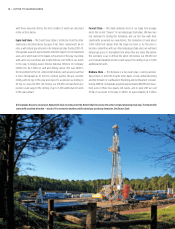Chesapeake Energy 2010 Annual Report Download - page 21
Download and view the complete annual report
Please find page 21 of the 2010 Chesapeake Energy annual report below. You can navigate through the pages in the report by either clicking on the pages listed below, or by using the keyword search tool below to find specific information within the annual report.
What advantages does CHK’s unique vertical integration strategy provide?
Chesapeake has built a large inventory of low-risk natural gas and liquids-rich plays that we plan to develop
aggressively over the next two decades. As a result, we know that our company will consistently utilize a tremen-
dous (and growing) amount of oilfield services for this resource development. This high level of planned drilling
activity will create value for the provider of oilfield services, and Chesapeake’s strategy is to capture a portion
of this value for our shareholders rather than transfer it to third-party vendors whose interests and investments
are not always aligned with ours. To date, Chesapeake has invested in drilling rigs, rental tools, water manage-
ment equipment, trucking, compression equipment, midstream services, and most recently pressure pumping and
fracture stimulation equipment. Chesapeake’s activities require a high level of planning and project coordination
that is best accomplished through vertical integration and ownership of the oilfield services we utilize. This approach
creates a multitude of cost savings, an alignment of interests, operational synergies, greater capacity of equipment,
increased safety and better coordinated logistics. In addition, Chesapeake’s control of a large portion of the oilfield
service equipment it utilizes provides a unique advantage to control the timing of leasehold development. Simply
put, faster development of resources maximizes the present value of leasehold. This has been a key advantage for
Chesapeake over the past three years as the company has monetized leasehold investments at premium values through our joint ventures.
Will U.S. natural gas prices reconnect with world natural gas prices?
Natural gas is a premium product and a cleaner-burning fuel than coal or oil-related products, including gasoline,
diesel and heating oil. Despite this fact, over the past two years natural gas has received a low price in the U.S.
market relative to coal and oil-related products, primarily as a result of a temporary surplus of production. This
surplus has been principally caused by high levels of drilling activity as producers focused on holding by produc-
tion (HBP) leasehold in new highly productive, low cost natural gas shale plays. In essence, producers reinvented
U.S. supply ahead of reinventing of U.S. demand. We believe HBP-incentivized drilling on natural gas plays will
largely come to an end in 2012, and U.S. demand will soon also be reinvented to allow U.S. natural gas prices to
reconnect to price parity with world natural gas prices that have risen to more than double U.S. natural gas prices.
This surge in world natural gas prices has been in response to $100+ oil prices and surging global liquefied
natural gas (LNG) demand. In our view, the arbitrage in value between competing fuels is simply too wide. Capital
and ideas will flow toward projects that make the most of this price disparity. Chesapeake and other companies are
working to create the ability to export natural gas from the U.S. Gulf Coast and other regions in the form of LNG to
premium Pacific Rim, European and South American markets, perhaps as soon as 2015. This initiative will also be
aided by the widening of the Panama Canal to accommodate large LNG vessels. Furthermore, we believe that the
current price disparity between natural gas and oil will increasingly lead to greater use of natural gas in the U.S. transportation system. Whether it
be compressed natural gas (CNG) for medium and light-duty vehicles, LNG for heavy-duty vehicles or the commercialization of gas-to-liquids (GTL)
natural gas refineries that supplement the U.S. liquid fuel supply stream, we believe that the marketplace will increasingly utilize and embrace natural
gas. Chesapeake is working with industry, public policymakers and potential partners on each of these demand reinvention opportunities. Natural
gas is clean, affordable, abundant and American. Why shouldn’t it trade at a BTU premium in the years ahead?
Why is an investment grade rating on its debt securities important to CHK?
We believe that Chesapeake will benefit in multiple ways from an investment grade rating on our debt
securities, which we hope to achieve in 2012 or 2013. First, a higher rating would obviously lower the company’s
borrowing costs over time. In addition, other less easily quantifiable benefits will also accrue to Chesapeake.
Higher debt ratings would result in lower costs on long-term firm transportation contracts that we enter into in
order to market our natural gas and oil production as well as facilitate our ability to enter into long-term contracts
to sell our natural gas production to international buyers in the form of LNG. An improved rating will also enhance
Chesapeake’s ability to further attract world-class energy companies to participate in our joint venture projects,
which profitably monetize a portion of our leasehold investments and also accelerate the development of our
resource base. Finally, and perhaps most importantly, we believe that reduced financial leverage and an invest-
ment grade rating will lead to a higher stock price and provide further interest from worldwide equity investors.
Jeff Fisher
Senior Vice President – Production
Nick Dell’Osso
Executive Vice President
and Chief Financial Officer
Jeff Mobley
Senior Vice President –
Investor Relations and Research
2010 ANNUAL REPORT | 21
























